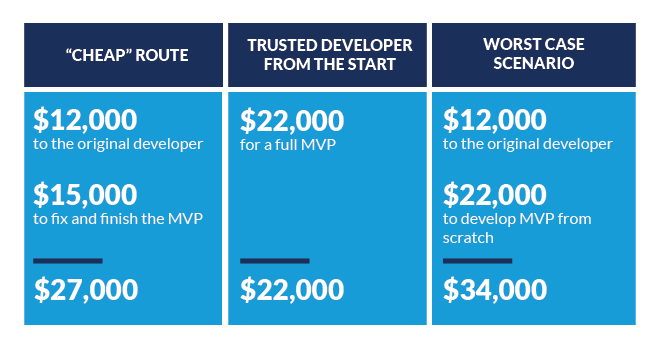<Hypothetical Scenario>
John wanted a developer to help him make his software as a service (SaaS) product a reality. He shopped around, got several bids, and found a cheap developer who could start right away. He got a low hourly rate and a dedicated team of developers.
That all sounds great, right?
A few months go by with little contact from the developer—other than the monthly invoices, of course.
Eventually, John received a test link to view the first version of the software. It wasn’t at all what he was expecting. It didn’t have many of the features he had discussed, the user interface was clunky, and there were typos
everywhere.
When he brought up his concerns to the developer, the developer responded, “We’ve fulfilled our contractual obligations.”
After some digging, John found out that the company has done this before.
The developer refused his request for a refund, even a partial one. While John wasn’t happy about it, he didn’t fight back. The developer did give John the source code.
John put away the project for six months to rebuild capital—after all, he lost his entire investment.
When he started looking for a new developer, he spent more time researching and did his due diligence. He asked for references and made sure they had an impressive portfolio.
He found a developer with a great portfolio and glowing references. Their estimate gave him sticker shock—especially having been burned the first time—but John really trusted this new developer.
Before signing the contract, the new developer took the time to understand John’s idea and the features his software application would need. They brought ideas to the table to make the application even better than he had originally planned.
The new developer got started. Luckily, some of the code from the old developer was usable. Many times, it’s not.
John was involved throughout the whole process with the new developer. He provided feedback on wireframes and designs, was in the loop on timelines and budget, and knew what to expect when he got the test link.
Just 15 weeks later, the new developer launched a minimum viable product (MVP) of John’s SaaS product. John and the new developer continued to work to build out the product, add more features, and take it to market.
And they all lived happily ever after.
John’s Costs*
Which really costs more?

*Again, this is all hypothetical—it’s made up.
</Hypothetical Scenario>
I see situations like this all the time. People looking to have something built go with the cheapest option. Often, in the end, that
route will cost more time, frustration, and yes, money.